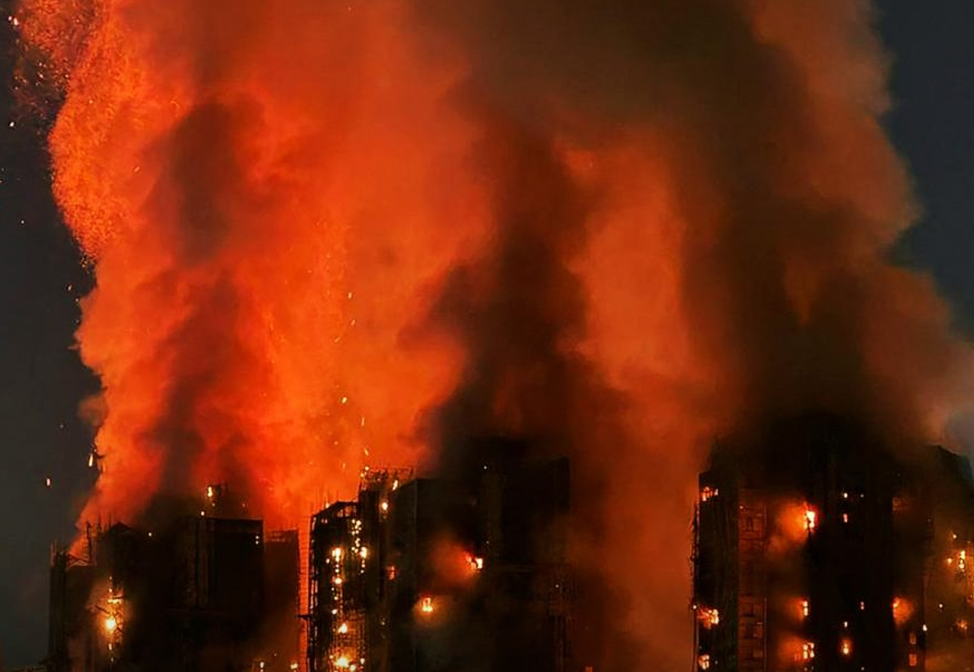The screams began long before the sirens could reach the scene. In the late afternoon, what started as an ordinary day in Tai Po, a usually calm housing estate in Hong Kong, turned into a nightmare that would sear itself into the city’s collective memory. Flames licked aggressively at the bamboo scaffolding wrapped around the high-rise towers, twisting the familiar, orderly skyline into a chaotic inferno. Thick black smoke curled upward, obscuring the sun and painting the sky in shades of fire and ash. Families were trapped inside their own apartments, their cries for help muffled by the roar of heat and collapsing structures. Windows shattered as heat pressed outward, sending shards like knives into the streets below.
Rescue teams arrived in minutes, but the estate had already transformed into a towering prison of smoke, flames, and chaos. Inside, firefighters and volunteers struggled against collapsing bamboo poles, falling glass, and treacherous hallways that threatened to swallow anyone who stepped forward. One firefighter slipped on debris, falling through the thick haze to the street below, leaving colleagues to carry on with trembling hands and clenched jaws. The missing numbered in the hundreds as emergency shelters quickly filled with displaced residents, many of them elderly or children who had nowhere else to turn. Every hour brought new horrors: families separated, belongings destroyed, and the terrifying realization that some doors would never open again, some lives lost forever.
By midnight, the once-proud Tai Po estate had become a dark silhouette against Hong Kong’s skyline. Its towers, once a symbol of routine city life, now stood scarred and smoking, etched into memory as sites of tragedy. Survivors wandered the streets in shock, clutching whatever possessions they could carry—blankets, shoes, identification papers. Their homes, along with decades of memories, had vanished in mere hours. Rescue workers continued to battle the fire, navigating corridors filled with heat so intense it burned through protective gear, and sifting through rubble that could collapse without warning. Families called frantically from nearby buildings, desperate for news of loved ones, while authorities attempted to coordinate search efforts in the chaos. Every floor revealed new dangers: precarious scaffolding ready to give way, flaming debris raining down, and pockets of smoke that moved unpredictably with gusts of wind.
Questions about the disaster now burn as fiercely as the flames themselves. How did the bamboo scaffolding, a common sight on renovation projects across Hong Kong, turn into a deadly fuse linking apartment to apartment? Why were residents allowed to remain in a construction zone so volatile, wrapped in flammable materials, and one errant spark away from catastrophe? City leaders issued statements promising thorough investigations, but their words did little to console those staring at the smoldering towers that had been home for years. Families waited in temporary shelters, shivering in borrowed clothes, haunted by the sight of their destroyed homes and the uncertainty of whether loved ones were still alive.
The death of a single firefighter has become a symbol of the city’s grief and resilience. Colleagues who survived speak in hushed tones of the bravery displayed in the inferno, while citizens leave flowers and candles near the gates of the estate. As the smoke slowly begins to clear, the full scale of the disaster is coming into focus: hundreds missing, countless homes destroyed, and a community forced to reckon with how quickly life can turn from ordinary to catastrophic. Experts warn that lessons must be learned immediately, that safety standards, emergency protocols, and construction oversight cannot fail again. Yet for now, the streets of Tai Po are filled with quiet anguish, muted sobs, and the lingering smell of ash, reminding everyone that Hong Kong has endured another night of fire, fear, and irrevocable loss.
Even as the city rallies around survivors, the human stories continue to emerge—neighbors rescuing neighbors, strangers sharing food and shelter, and children trying to understand why their homes no longer exist. Each tale layers onto the next, weaving a tapestry of survival against impossible odds. The estate’s familiar corridors, once filled with laughter and the hum of everyday life, are now silent save for the crackle of lingering flames and the low murmur of those picking through what remains. For Tai Po and Hong Kong, the fire is more than a tragedy—it is a turning point, a reminder of both fragility and resilience, a scar burned into memory that will not soon fade.
The investigation has begun, but the hearts of the survivors are the true measure of this disaster. As Hong Kong braces for the long recovery, the voices of the missing echo in the streets, the rubble holds stories untold, and every rescued life becomes a beacon of hope in the darkness. In a city that never sleeps, the night of the fire will be remembered as a time when ordinary people faced extraordinary terror—and in many cases, survived to tell the tale.
